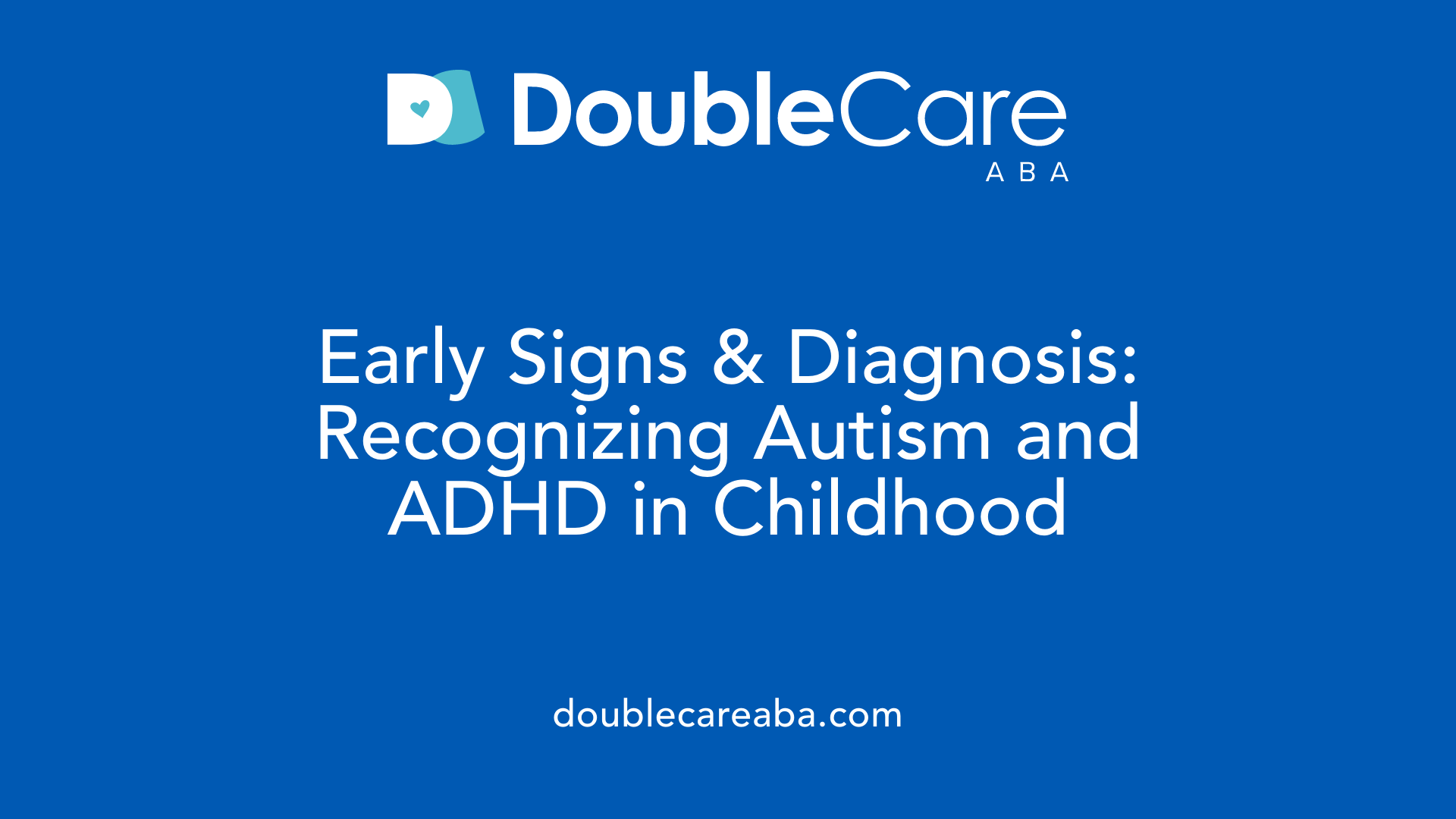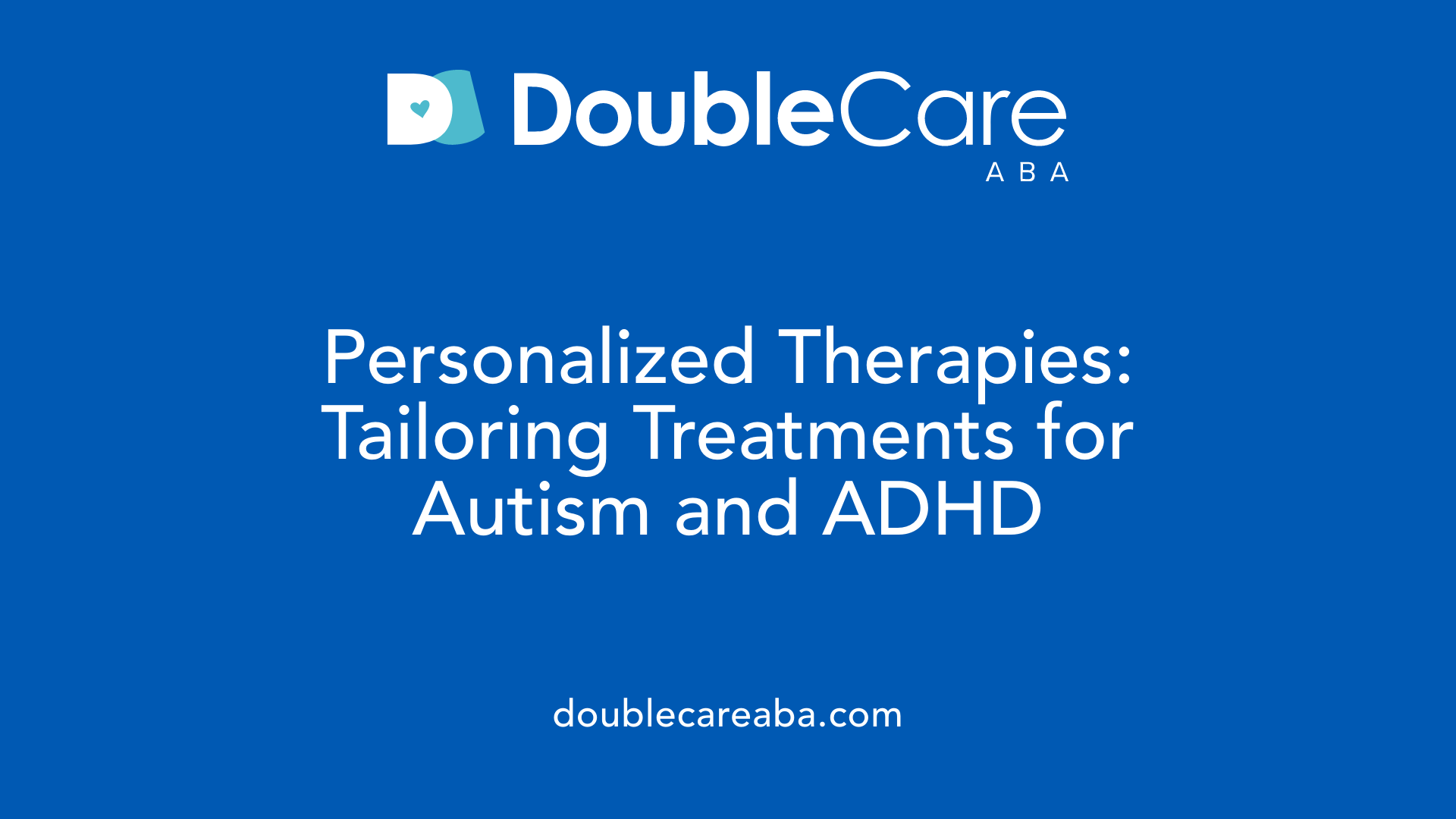Understanding the Neurodevelopmental Landscape
Autism Spectrum Disorder (ASD) and Attention Deficit Hyperactivity Disorder (ADHD) are distinct yet often overlapping neurodevelopmental conditions affecting millions worldwide. Both start early in childhood and influence behavior, communication, learning, and emotional regulation throughout life. Despite their complexities and shared traits, they require nuanced understanding and personalized interventions. This article explores the unique and overlapping symptoms of autism and ADHD, their diagnostic challenges, treatment methodologies including Applied Behavior Analysis (ABA) therapy, and the importance of tailored, multidisciplinary approaches for those living with one or both conditions.
Defining Autism Spectrum Disorder and ADHD: Key Characteristics and Differences

Core symptoms of ASD and ADHD
Autism Spectrum Disorder (ASD) mainly affects social communication and behavior. It is characterized by difficulties in social interaction, challenges with understanding social cues, and the presence of restrictive and repetitive behaviors. In contrast, Attention-Deficit/Hyperactivity Disorder (ADHD) is defined by symptoms such as inattention, hyperactivity, and impulsivity, which affect daily functioning and relationships.
How autism impacts social communication and behavior
Individuals with autism often struggle with social skills including maintaining eye contact, expressing empathy, and interpreting nonverbal communication. Repetitive behaviors and sensory sensitivities are common, serving as self-soothing mechanisms. Early signs include delayed language development and a lack of social interest.
Distinct features of ADHD including attention, hyperactivity, and impulsivity
ADHD symptoms involve difficulty focusing, excessive talking, restlessness, and impulsive behaviors. Children may have trouble sitting still, following instructions, and are easily distracted by external stimuli. Adults with ADHD often face challenges in focus, impulse control, and managing hyperactivity.
How symptoms manifest differently in children and adults
Both ASD and ADHD symptoms typically appear in early childhood, but their presentation can evolve with age. Children with autism may show intense focus on specific interests and social withdrawal, while adults may struggle with social reciprocity and conversation. Similarly, ADHD in children often presents as hyperactivity and impulsivity, which may become more subtle but persistent attention difficulties and restlessness in adults.
Understanding these distinctive but sometimes overlapping characteristics is crucial for early diagnosis and personalized interventions to support individuals across all ages.
Symptom Overlap and Co-occurrence: Navigating Dual Diagnoses

What Are Common Overlapping Symptoms Between ADHD and Autism?
Both ADHD and Autism Spectrum Disorder (ASD) share several symptoms that can make distinguishing between them challenging. Individuals with these conditions often experience difficulties with attention and focusing. Sensory sensitivities are another shared trait, where certain sounds, lights, or textures may cause discomfort or distraction.
Besides attention problems, both disorders can involve social challenges such as trouble understanding social cues and difficulties in maintaining conversations. Emotional regulation issues, including strong reactions and sleep disturbances, are also common to both.
How Common Is It for Someone to Have Both Autism and ADHD?
Research shows a significant overlap between autism and ADHD, with estimates indicating that about 40% to 70% of individuals diagnosed with ASD also exhibit symptoms typical of ADHD. This co-occurrence is recognized officially in diagnostic manuals, emphasizing the need to consider dual diagnoses in evaluations.
What Challenges Arise From Having Both ADHD and Autism?
A dual diagnosis can complicate behavior and social interactions. For example, someone might experience conflicting needs such as craving high levels of stimulation (common in ADHD) while simultaneously needing predictability and routine (often preferred by individuals with autism).
This combination can lead to behaviors like sensory challenges, social isolation, and difficulties processing information. Managing these mixed symptoms often requires personalized interventions that address both sets of challenges rather than treating each condition in isolation.
How Do Conflicting Needs Manifest in Dual Diagnosis?
Living with both ADHD and autism can involve navigating opposing tendencies. For instance, ADHD might drive a person toward impulsive and hyperactive behaviors seeking constant stimulation. In contrast, autism might cause them to prefer structured environments and predictable routines, creating internal conflict.
This balance can make everyday activities and social situations more complex. Understanding and respecting these mixed needs is essential for using effective therapeutic approaches and supporting individuals in their unique experiences.
Early Signs and Diagnostic Processes for Autism and ADHD

Early Childhood Symptoms Unique to ASD and ADHD
Early symptoms of Autism Spectrum Disorder (ASD) generally present in early childhood and include delayed language development, social withdrawal, unusual social interactions, and repetitive behaviors that often serve as self-soothing mechanisms. Children with ASD may also show difficulties in understanding sarcasm, humor, and nonverbal cues.
In contrast, ADHD symptoms in young children commonly manifest as difficulty staying on task, fidgeting, hyperactivity, impulsive behaviors, and trouble following instructions. Children with ADHD frequently interrupt others and have problems sitting still.
Diagnostic Tools and Procedures Including Behavioral Observation and History
Diagnosis of both ASD and ADHD primarily relies on careful behavioral observation and detailed developmental history. There are currently no definitive blood tests or biological markers for either disorder. Assessments incorporate interviews with parents, teachers, and caregivers, alongside standardized rating scales and clinical observations of behavior across settings.
For Autism, multidisciplinary teams of specialists often conduct thorough evaluations, reviewing speech, social interaction, and behavioral patterns. ADHD assessments typically involve input from multiple sources and use diagnostic criteria such as those found in the DSM-5.
Differential Diagnoses Considered During Assessment
During diagnosis, professionals consider a range of other neurodevelopmental and mental health disorders to rule out conditions with overlapping features. For ADHD, differential diagnosis may include anxiety disorders, learning disabilities, and mood disorders. In ASD assessments, related conditions such as Rett syndrome, language disorders, and schizophrenia are evaluated to ensure accurate identification.
Importance of Early and Accurate Diagnosis for Management
Early and accurate diagnosis of ASD and ADHD is crucial in enabling timely intervention, which can significantly improve developmental outcomes and quality of life. Early identification allows for personalized treatment plans that may include behavioral therapies, speech and occupational therapies, social skills training, and medication management when appropriate. Prompt diagnosis also supports family education and coping strategies, helping address the diverse needs of affected individuals effectively.
Therapeutic Approaches: Tailoring Treatment to Individual Needs

Overview of therapeutic strategies for ASD and ADHD
Treatment for Autism Spectrum Disorder (ASD) often centers around behavioral therapies such as Applied Behavior Analysis (ABA), social skills training, speech and occupational therapies, and customized educational plans. ADHD treatments typically include medication—mainly stimulants—and behavioral therapies like Cognitive Behavioral Therapy (CBT). Educational interventions with structured routines and visual supports are also common for ADHD.
Differences in treatment focus such as medication for ADHD versus behavioral therapies for autism
Medication plays a significant role in managing ADHD symptoms, helping improve attention and reduce impulsivity and hyperactivity. Conversely, medication is not a standard treatment for autism; instead, interventions focus on behavioral and developmental therapies aiming to enhance communication, social skills, and reduce repetitive or challenging behaviors.
Challenges in traditional therapies due to neurodiversity
Standard therapies often face challenges when treating neurodiverse individuals. For example, CBT may not fully address ADHD’s heterogeneity because of difficulties with cognitive flexibility. Similarly, traditional talk therapies can overwhelm autistic individuals due to sensory sensitivities and emotional communication difficulties like alexithymia. These challenges necessitate therapy adaptations that respect individual differences.
Necessity of flexible, personalized, and multidisciplinary approaches
Given the complexity and co-occurrence of ASD and ADHD, effective treatment hinges on flexible, personalized care. This approach includes combining therapies—such as behavioral, speech, occupational, and social skills training—with family involvement and educational support. Medication is integrated when appropriate. Multidisciplinary plans recognize neurodiversity, accommodate unique needs, and improve overall quality of life for individuals managing these conditions.
Applied Behavior Analysis (ABA) Therapy: What Is It and How Does It Help?
What is Applied Behavior Analysis (ABA) therapy?
Applied Behavior Analysis (ABA) therapy is a science-driven, individualized approach focused on understanding and modifying behaviors. It relies on learning theory principles by analyzing the antecedents, behaviors, and consequences (often called the ABCs) to identify what triggers specific actions and what outcomes follow.
Techniques within ABA
ABA uses various techniques including positive reinforcement—rewarding desirable behaviors to increase their frequency. Prompting helps guide individuals toward a correct response, while naturalistic teaching integrates learning in everyday activities. These methods work together to boost helpful behaviors and reduce ones that may cause challenges.
Role of certified behavior analysts and individualized plans
Certified Behavior Analysts (BCBAs) develop personalized treatment plans based on thorough behavioral assessments. These plans often involve intensive sessions tailored to each person's unique needs, promoting skills that improve communication, social interactions, and daily living.
Evidence supporting ABA’s effectiveness
Extensive research has demonstrated ABA’s effectiveness, particularly for individuals with autism spectrum disorder (ASD). It can enhance social and communication abilities, reduce repetitive behaviors, and improve quality of life by fostering independence and adaptive functioning.
Overall, ABA therapy stands as a cornerstone treatment for ASD and supports individuals in reaching their full potential through structured, evidence-based intervention.
How ABA Therapy Benefits Individuals with Autism
Improvement in Communication, Social Interaction, and Daily Living Skills
Applied Behavior Analysis (ABA) therapy is a highly effective approach that helps individuals with autism develop vital skills. It focuses on enhancing communication abilities, improving social interactions, and supporting daily living tasks such as personal care and academic skills. These improvements allow individuals to better engage with their environment and increase their functional independence.
Use of Positive Reinforcement and Structured Teaching Methods
ABA therapy relies heavily on positive reinforcement to encourage desirable behaviors. By rewarding progress and appropriate responses, it motivates individuals to practice and retain new skills. The therapy also uses systematic and structured teaching techniques that break tasks into manageable steps, making learning more accessible and consistent.
Importance of Early and Intensive Intervention
Early diagnosis and intervention with ABA can significantly improve developmental outcomes. Intensive early therapy, especially for young children, promotes quicker mastery of skills and reduces challenging behaviors. Starting ABA at a young age leverages neuroplasticity, helping children adapt and progress more effectively.
Enhancement of Independence and Coping with Emotions
Beyond skill acquisition, ABA therapy aids in developing emotional regulation and coping mechanisms. It equips individuals with strategies to manage feelings and reactions, fostering greater independence and self-confidence. This holistic approach contributes to a better quality of life and smoother transitions into varied social and educational settings.
Delivery of ABA Therapy: Providers and Session Components
Who Provides ABA Therapy?
ABA therapy is delivered by a specialized team focused on behavior analysis. The primary figure in this team is the Board Certified Behavior Analyst (BCBA), who designs comprehensive treatment plans tailored to each individual's strengths and needs. They oversee the entire intervention process to ensure quality and efficacy.
Supporting the BCBA are therapy assistants or technicians who implement the ABA strategies directly with the clients. These technicians work under the BCBA’s supervision, carrying out daily therapy sessions and interventions.
ABA therapy can be administered across diverse settings, such as specialized clinics, schools, and the child's home environment, ensuring flexibility and consistency in treatment.
Core Components of ABA Therapy Sessions
ABA sessions revolve around a few foundational elements:
Assessment and Individualized Planning: Each child's behavior, skills, and needs are thoroughly assessed to form a personalized treatment plan with clear objectives.
Discrete Trial Training (DTT): This structured teaching method breaks skills into small, manageable parts and uses repetitive trials to promote learning.
Natural Environment Training (NET): Teaching occurs in everyday settings, helping children apply skills in real-life situations.
Data Collection: Therapists continuously document progress to monitor effectiveness and make necessary adjustments.
Understanding Behavior Patterns: Interventions rely on analyzing antecedents (what happens before behavior) and consequences (what follows) to encourage positive behaviors.
Parental Involvement and Skill Generalization
Parents and caregivers play a crucial role by receiving training to support the transfer of skills beyond therapy sessions. This involvement promotes generalization, ensuring children carry learned abilities into home, school, and social settings.
Overall, ABA therapy sessions balance structured activities and natural interactions, adapting approaches to each child to enhance social, communication, and behavioral development effectively.
Challenges in Therapy for Autism and ADHD: Beyond Traditional Models
Limitations of Deficit-Focused Cognitive Behavioral Therapy (CBT) for ADHD
Cognitive Behavioral Therapy (CBT) is a common treatment for ADHD, focusing on changing negative behaviors and thought patterns. However, its deficit-focused nature can limit its effectiveness. Individuals with ADHD often have heterogeneous symptoms, including challenges with cognitive flexibility, which can make traditional CBT techniques, like thought re-framing, difficult to apply.
Emotional Communication Difficulties and Therapy Engagement Issues in Autism
Autistic individuals frequently experience difficulties with emotional communication, such as alexithymia, where recognizing and expressing emotions is impaired. This can make standard talking therapies challenging to engage with. Additionally, sensory overload and misaligned therapeutic goals may hinder therapy progress as autistic people may feel overwhelmed or misunderstood in traditional settings.
Misinterpretation of Autistic Burnout as Depression
Burnout in autistic individuals, characterized by extreme exhaustion and reduced functioning, is often mistaken for depression. This misinterpretation can lead to inappropriate treatment plans, which do not address the underlying causes specific to autism-related burnout, thereby complicating effective intervention.
Need for Neurodiversity-Aware and Flexible Therapeutic Approaches
There is growing recognition of the importance of therapies that embrace neurodiversity and adapt to individual needs. Effective interventions for both ADHD and autism emphasize flexibility, personalized strategies, and understanding unique neurodiverse experiences. This approach ensures therapy is not one-size-fits-all but tailored to respect and support each person's distinct strengths and challenges.
Enhancing Quality of Life: Multidisciplinary Care and Family Involvement
Combining Behavioral Therapies, Speech, Occupational Therapy, and Educational Support
Effective management of ADHD and autism involves a multidisciplinary approach. Behavioral therapies like Applied Behavior Analysis (ABA) focus on improving communication and reducing challenging behaviors in autism, while ADHD treatments aim to enhance attention, reduce impulsivity, and teach self-regulation. Speech therapy addresses communication difficulties, occupational therapy targets sensory processing and motor skills, and educational support creates tailored learning environments suited to individual needs.
Medication Management for ADHD Symptoms
Medication, primarily stimulants, plays a crucial role in managing ADHD symptoms by improving attention and reducing hyperactivity and impulsivity. Unlike autism, where medication use is minimal, appropriate pharmacological intervention for ADHD complements behavioral and educational therapies to achieve better outcomes.
Support for Social Skills, Sensory Integration, and Life Skills
Social skills training helps children and adults with ADHD and autism improve peer interactions and social communication. Sensory integration therapy assists in managing sensory sensitivities common in both conditions. Additionally, life skills support, including education, vocational training, and cognitive flexibility strategies, is vital, especially for individuals with co-occurring diagnoses, who may face conflicting needs like craving stimulation while needing predictability.
The Critical Role of Families and Personalized Care Plans in Treatment Success
Families are central to treatment success. Personalized care plans that incorporate a family's understanding of the individual's unique neurodiverse profile ensure therapies and interventions are flexible and tailored. This collaborative approach improves engagement, emotional regulation, and quality of life, recognizing the importance of addressing both neurodevelopmental and emotional challenges across the lifespan.
Toward Personalized Understanding and Support
Autism and ADHD are intricate neurodevelopmental conditions with overlapping and distinct features that challenge diagnosis and treatment. Through early and accurate identification, tailored behavioral therapies like ABA, and comprehensive multidisciplinary care, individuals with these conditions can achieve meaningful improvements in communication, social skills, and daily functioning. Addressing the individual’s unique neurodiverse profile and engaging families in the therapeutic process are essential to enhancing quality of life. As research and clinical practices continue to evolve, embracing flexibility and personalized approaches remains key to effectively supporting people living with autism, ADHD, or both.
References
- ADHD vs Autism Symptom Comparison
- Key Differences Between ADHD and Autism Spectrum ...
- Understanding and Differentiating Between Autism and ...
- ADHD vs. Autism: Understanding Differences, Similarities, ...
- Tailoring Approaches for ADHD and Autism
- Understanding the Difference Between Autism and ADHD
- The Differences Between Autism and ADHD | Inclusive ABA
- Applied Behavior Analysis (ABA)
- Applied Behavior Analysis (ABA)
- 6 Benefits of ABA Therapy for Children with Autism














